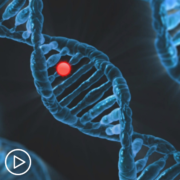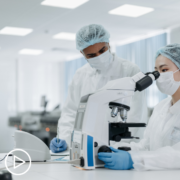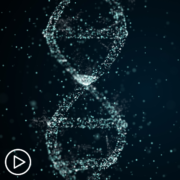Why Is the Menin Pathway Important in AML?
Why Is the Menin Pathway Important in AML? from Patient Empowerment Network on Vimeo.
What should acute myeloid leukemia (AML) patients know about the menin pathway? Dr. Naval Daver from the University of Texas MD Anderson Cancer Center shares information from ASH 2022. .Learn research updates about the menin pathway and ongoing clinical trials on the pathway.
[ACT]IVATION TIP from Dr. Daver: “Patients should be checked for arrangements like MLL rearrangement NPM1 mutation, new fusions as these may be amenable to therapy with the menin inhibitors, there are multiple trials with five different menin inhibitors, single agent trials and also combination trials now ongoing across multiple centers both in the U.S. and ex-U.S.“
Download Resource Guide en español
Related Resources:

What Are Some Clinical Predictors for Relapse in Acute Myeloid Leukemia? |

|

|
Transcript:
Art:
Dr. Daver, what is a menin pathway in AML? And why is it significant?
Dr. Naval Daver:
The menin pathway is very recently discussed that way, the pathway, of course, itself has been known for almost a decade, this is an epigenetic pathway, and in certain subsets of AML such as MLL rearranged NPM1 mutated as well as other fusions, we find that there is an up regulation of the menin impact rearrangement, and this actually results in increased production of two enzymes called meis-1 and hox-DNA) these enzymes actually result in a differentiation blockade. So normally, in the bone marrow we have the early progenitor cells, this then leads to be a report cell and leads to mature neutrophils and monocytes and blood cells, but in a differentiation blockade, we would see that those cells over time would start generating mutations and become leukemic cells.
So one of the most physiological ways to treat AML is to actually remove the differentiation blockade, so the normal process of differentiation with progress, and so these menin inhibitors are able to reduce the levels of MEIS1 and HOXA by doing this, they allow the normal differentiation cascade to progress, and they’re not cytotoxic targeted chemo, they’re not directly killing leukemia, but they’re actually allowing the leukemia itself to then mature to no monocytes and neutrophils.
And so now there are five different menin inhibitors in ongoing clinical trials, but two of these are more advanced and have shown data recently in the ASH 2022 meeting the newer drugs, and are showing close to 40 to 50 percent single agent efficacy, and we believe that after the FLT3, IDH1, IDH2 inhibitors, which have been approved in the last five years, the menin inhibitors are probably the next other targeted therapies that will hopefully get approval and they eventually be used in the frontline setting in combination approaches.
The activation tip related to this question is that patients should be checked for arrangements like MLL rearrangement NPM1 mutation, new fusions as these may be amenable to therapy with the menin inhibitors, there are multiple trials with five different menin inhibitors, single agent trials and also combination trials now ongoing across multiple centers both in the U.S. and ex-U.S., and if one does have an aberration that will be sensitive to such menin inhibitor-based therapy, I would strongly recommend considering trying to get on one of those trials because we believe that these will be the best outcomes with such standard therapies rather than using the standard or traditional chemotherapies.






